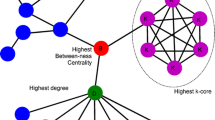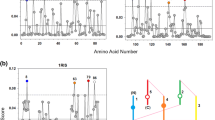Abstract
The three-dimensional structure of a protein can be described as a graph where nodes represent residues and interactions between them are edges. We have constructed protein contact networks at different length-scales for different interaction strength cutoffs. The largest connected component of short-range networks exhibit a highly cooperative transition, while long- and all-range networks (more similar to each other), have less cooperativity. The hydrophobic subnetworks in all- and long-range networks have similar phase transition behaviours while hydrophilic and charged networks don’t. Hydrophobic subclusters in long- and all-range networks exhibit higher occurrence of assortativity and hence higher communication ability in transmitting information within a protein. The highly cliquish hydrophobic nodes in long- and short-range networks play a significant role in bridging and stabilizing distantly placed residues during protein folding. We have also observed a significant dominance of charged residues cliques in short-range networks.
Access this chapter
Tax calculation will be finalised at checkout
Purchases are for personal use only
Preview
Unable to display preview. Download preview PDF.
Similar content being viewed by others
References
BoIde, C., KovaIcs, I.A., Szalay, M.S., Palotai, R., KorcsmaIros, T., Csermely, P.: Network analysis of protein dynamics. FEBS Lett. 581, 2776–2782 (2007)
Brinda, K.V., Vishveshwara, S.: A network representation of protein structures: implications to protein stability. Biophys. J. 89, 4159–4170 (2005)
Greene, L.H., Higman, V.A.: Uncovering network systems within protein structures. J. Mol. Biol. 334, 781–791 (2003)
Dokholyan, N.V., Li, L., Ding, F., Shakhnovich, I.: Topological determinants of protein folding. Proc. Natl. Acad. Sci. USA 99, 8637–8641 (2002)
del Sol, A., Fujihashi, H., Amoros, D., Nussinov, R.: Residues crucial for maintaining short paths in network communication mediate signaling in proteins. Mol. Syst. Biol. 2 (2006); 2006.0019
Amitai, G., Shemesh, A., Sitbon, E., Shklar, M., Netanely, D., Venger, I., Pietrokovski, S.: Network analysis of protein structures identifies functional residues. J. Mol. Biol. 344, 1135–1146 (2004)
Vendruscolo, M., Dokholyan, N.V., Paci, E., Karplus, M.: Small-world view of the amino acids that play a key role in protein folding. Phys. Rev. E 65, 06191 (2002)
Kundu, S.: Amino acids network within protein. Physica A 346, 104–109 (2005)
Aftabuddin, M., Kundu, S.: Weighted and unweighted network of amino acids within protein. Physica A 39, 895–904 (2006)
Aftabuddin, M., Kundu, S.: Hydrophobic, hydrophilic, and charged amino acid networks within protein. Biophys. J. 93, 225–231 (2007)
Gromiha, M.M., Selvara, S.: Influence of medium and long-range interactions in protein folding. Prep. Biochem. and Biotechnol. 29, 339–351 (1999)
Go, N., Taketomi, H.: Respective roles of short- and long-range interactions in protein folding. Proc. Natl. Acad. Sci. USA 75, 559–563 (1978)
Selvaraj, S., Gromiha, M.M.: Role of hydrophobic clusters and long-range contact networks in the folding of (α/β)8 barrel proteins. Biophys. J. 84(3), 1919–1925 (2003)
Brinda, K.V., Vishveshwara, S., Vishveshwara, S.: Random network behaviour of protein structures. Mol. BioSyst. 6, 391–398 (2010)
Deb, D., Vishveshwara, S., Vishveshwara, S.: Understanding protein structure from a percolation perspective. Biophysical Journal 97(6), 1787–1794 (2009)
Tinoco, I., Sauer, K., Wang, J.C.: Physical Chemistry: Principles and Application in Biological Sciences. Prentice-Hall, Englewood Cliffs (2001)
Newman, M.E.J.: Assortative mixing in networks. Phys. Rev. Lett. 89, 208701–208704 (2002)
Segel, I.H.: Biochemical Calculations. John Wiley and Sons, New York (1997)
Maity, H., Maity, M., Krishna, M.M.G., Mayne, L., Englander, S.W.: Protein folding: the stepwise assembly of foldon units. Proc. Natl. Acad. Sci. USA 102, 4741–4746 (2005)
Bagler, G., Sinha, S.: Assortative mixing in protein contact networks and protein folding kinetics. Bioinformatics 23, 1760–1767 (2007)
Author information
Authors and Affiliations
Editor information
Editors and Affiliations
Rights and permissions
Copyright information
© 2012 Springer-Verlag Berlin Heidelberg
About this paper
Cite this paper
Sengupta, D., Kundu, S. (2012). Role of Physico-chemical Properties of Amino Acids in Protein’s Structural Organization: A Network Perspective. In: Lones, M.A., Smith, S.L., Teichmann, S., Naef, F., Walker, J.A., Trefzer, M.A. (eds) Information Processign in Cells and Tissues. IPCAT 2012. Lecture Notes in Computer Science, vol 7223. Springer, Berlin, Heidelberg. https://doi.org/10.1007/978-3-642-28792-3_11
Download citation
DOI: https://doi.org/10.1007/978-3-642-28792-3_11
Publisher Name: Springer, Berlin, Heidelberg
Print ISBN: 978-3-642-28791-6
Online ISBN: 978-3-642-28792-3
eBook Packages: Computer ScienceComputer Science (R0)




